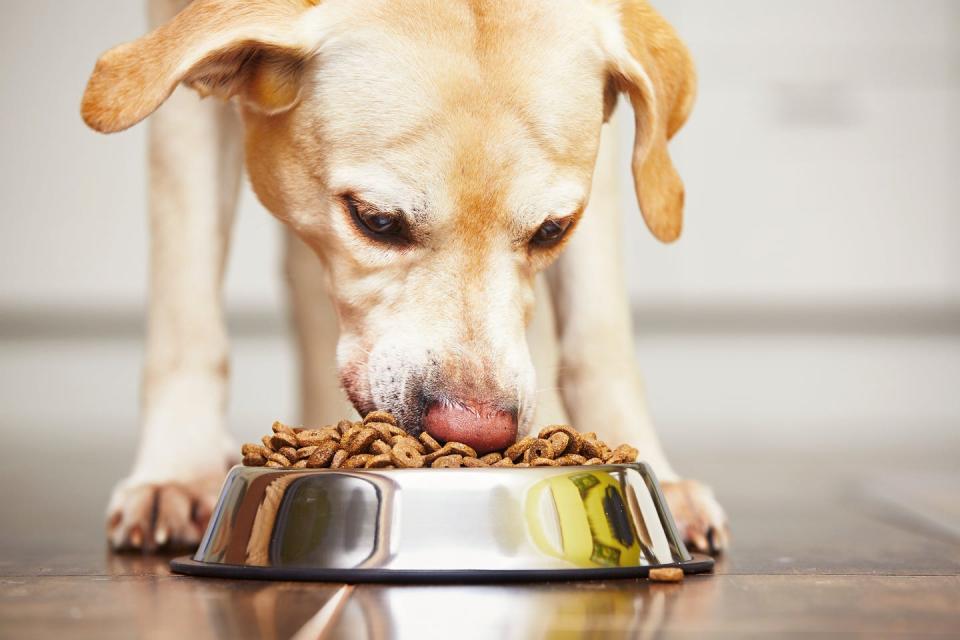This is how much you should be feeding your dog

If you’ve ever worried that you might be overfeeding or underfeeding your beloved dog, you’re not the only one.
But as you might expect, there’s no one-size fits all amount that works for all dogs. Not only do size and activity levels play a role, but “life stage and any health conditions should be taken into consideration too", explains Dr Anna Foreman, in-house vet at Everypaw Pet Insurance.
No matter what stage they are in their life, proper nutrition is essential for keeping our dogs healthy, as well as making sure that they are eating the right amount. For example, “obesity can lead to many health concerns in dogs – and cats – such as diabetes,” Anna explains. Plus, “an obese animal poses a greater risk under anaesthetic and when exercising in hot weather, and obesity can lead to faster progression of diseases such as osteoarthritis.”
This is why it is so important to ensure that our dog is a healthy weight.
There are some ways to work out exactly how much you should be feeding a dog, when taking several different factors into account. Keep reading to find out everything you need to know…
How much to feed a dog by weight

To work this out, Anna has a handy calculation that should help. Essentially you take their body weight in kilograms (kg) and multiply this by 30 and add 70.
So, “for a 10kg dog, this works out at 370 kcal/day – this is their resting energy requirement (RER) or the amount of calories they require to maintain their current weight without taking into account their activity levels.”
Once you have this figure, if you’re looking to put your dog on a diet to lose some extra pounds, “you should calculate this value using the dog’s IDEAL not CURRENT body weight,” Anna suggests.
Alternatively, if weight gain is required, you should again make this calculation with the dog’s IDEAL not CURRENT body weight and then multiply the RER by 1.2 to 1.8 to get the correct amount.
You’ll be able to tell whether your dog is over or underweight simply by giving them a quick check. “A healthy body condition for a dog,” is when “you should be able to feel but not see your dog's ribs, and they should have a visible waist when viewed from above,” says David D'Angelo, pet nutritionist and founder of Petfood Reviews. “If your dog is looking a bit round, gradually reduce the amount you're feeding. If their ribs are too prominent, increase the amount."

“For a neutered adult who is relatively active, 1.6 x RER should be fed in calories to account for their activity levels. Whereas if they are un-neutered, 1.8 x RER should be fed in calories,” Anna adds.
Very active working dogs, such as Border Collies and Golden Retrievers, who are constantly on the go, actually require 2-5 times their resting energy requirement to guarantee that they’re getting enough energy to keep them going throughout the day.
How many calories are in dog food?
On average, dry food tends to contain more calories per gram than wet food. Anna reveals that “dry food contains around 300kcal/100g, while wet food contains around 90kcal/100g.”
Based on these values, you can work out how many grams of food your dog should be eating each day.
“For adult dogs, two meals per day is typically sufficient,” David explains. “A good starting point is to follow the feeding guidelines provided on your dog's food label. However, these are just general recommendations, so you'll want to keep an eye on your dog's body condition and adjust the amount up or down as needed to maintain an ideal weight.”

Puppies also tend to need more calories per pound than a fully grown adult dog does. This is because they are growing and developing at a rapid rate. “Feeding puppies 3-4 meals per day, transitioning to 2 meals per day by around 6 months old,” David recommends.
Also, just like human diets, higher-calorie foods are better in moderation or smaller portions to stop you from using up most of their allowance in one sitting.

What weight should my dog be?
There is such a thing as a body condition score when it comes to animals, with this being a number up to nine. The ideal score is either four or five.
This score is determined by the amount of fat covering their ribs and spine and, ultimately, this is the number that you should be aiming for, instead of a specific weight. The PDSA has more advice on how to measure your dog’s body condition score.
You Might Also Like


